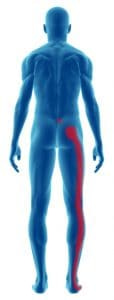What is sciatica?
Sciatica is not a diagnosis rather an umbrella term used to describe a collective group of symptoms which are due to pressure or irritation of the sciatic nerve anywhere along its pathway. It does not tell you anything about what is causing this irritation just that there is a problem somewhere along the nerve. It can be confused with other conditions which result in very similar symptoms without any sciatic nerve involvement at all.
Symptoms
Common symptoms include:
- leg buttock and back pain which often tends to be a sharp shooting pain
- numbness into the thigh, calf and or foot on the side of irritated nerve
- pins and needles into the same areas
- weakness into the leg muscles
If you start to notice changes in your bowel and bladder control and or numbness into the saddle area or unexplained weight loss with the above symptoms you should visit your doctor to make sure that there is not a more serious problem causing your pain.
Anatomy
The sciatic nerve is the largest and longest nerve in the body and it originates from the lower spine L4 to S3 (lower lumbar and upper sacral) nerve roots. These are the nerves which arise from the spinal cord and exit the spinal column through small holes known as vertebral foramen, these then join together to form the sciatic nerve deep within the pelvis. The nerve from here travels into the buttock down the back of the thigh to just above the knee where it splits into two, the peroneal and tibial nerves. These then continue down the back of the leg and into the foot. The sciatic nerve supplies both the muscles and sensory sensation of the thigh, leg and foot. Therefore pressure or irritation on this nerve at any point along its path from where it originates in the spine to where it ends in the foot can cause any of the symptoms of sciatica as described above.
Causes
A prolapsed disc is the most common cause of true sciatica. This can sometimes be inaccurately described as a “slipped disc”. This colloquial term is very misleading as the discs, by their nature and anatomical location, cannot simply “slip” in or out of place but they can bulge or indeed burst.
Spinal stenosis (narrowing of the spinal canal) can occur as part of the natural ageing process. As we get older the spinal ligaments thicken and bony processes of the vertebrae called osteophytes develop to help stabilise the spine. This results in smaller vertebral foramen for the nerve roots to pass through, and hence nerve irritation can occur.
Piriformis syndrome is the compression of the sciatic nerve as it passes through the piriformis (deep buttock muscle). This only occurs when the muscle is in spasm.
There are other conditions as discussed above which can cause sciatic like symptoms without any involvement of the sciatic nerve at all. These include
- lumbar facet joint irritation (joints in the low back)
- myofascial trigger points in the buttock muscles
- or a combination of the above
Outcomes
True sciatica is often multifactorial in nature, therefore there is usually more going on than just the irritation of the sciatic nerve including myofascial changes (muscle tightness and weakness) and biomechanical adaptations which all can lead to the development and progression of symptoms. As such both true sciatica and the other conditions mentioned above all tend to respond favourably to conservative care. In fact very few episodes go on to require surgical intervention so it is advisable to seek advice and/or treatment from a primary healthcare physician such as a physiotherapist, chiropractor or osteopath.


